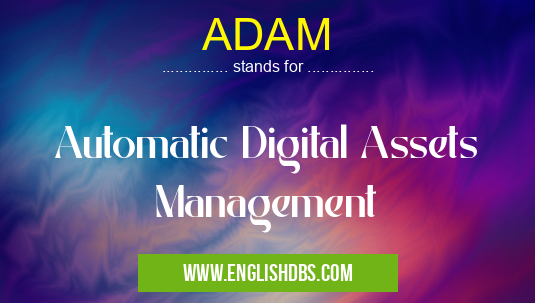What does ADAM mean in MANAGEMENT
ADAM (Automatic Digital Assets Management) is a specialized software solution designed to streamline and automate the management of digital assets within an organization. It provides a central repository for storing, organizing, and tracking all types of digital content, including images, videos, documents, audio files, and more.

ADAM meaning in Management in Business
ADAM mostly used in an acronym Management in Category Business that means Automatic Digital Assets Management
Shorthand: ADAM,
Full Form: Automatic Digital Assets Management
For more information of "Automatic Digital Assets Management", see the section below.
» Business » Management
Key Features of ADAM
- Centralized Storage: ADAM consolidates all digital assets into a single, secure, and easily accessible location. This eliminates the need for multiple storage systems and reduces the risk of data loss or duplication.
- Metadata Management: ADAM allows users to add and manage metadata to each asset, such as keywords, tags, descriptions, and copyright information. This makes it easy to search, filter, and organize assets based on specific criteria.
- Workflow Automation: ADAM can automate various tasks related to asset management, such as uploading, tagging, version control, and distribution. This streamlines the workflow and frees up users to focus on more strategic tasks.
- Access Control: ADAM provides granular access controls to ensure that only authorized users can access and modify assets. This helps maintain data security and privacy.
- Integration: ADAM can integrate with other business systems, such as content management systems (CMS) and enterprise resource planning (ERP) solutions, to provide a seamless workflow.
Benefits of Using ADAM
- Improved Efficiency: By automating tasks and providing a central repository, ADAM significantly improves the efficiency of digital asset management.
- Enhanced Accessibility: All digital assets are easily accessible from a single location, making them readily available to users across the organization.
- Reduced Costs: ADAM eliminates the need for multiple storage systems and manual processes, reducing operational costs.
- Increased Security: Centralized storage and access controls ensure the security and integrity of digital assets.
- Improved Collaboration: ADAM facilitates collaboration by providing a shared platform for asset management and distribution.
Essential Questions and Answers on Automatic Digital Assets Management in "BUSINESS»MANAGEMENT"
What is ADAM (Automatic Digital Assets Management)?
ADAM is an advanced software system designed to automate and streamline the management of digital assets, making it easier for organizations to store, organize, search, and share their digital content efficiently.
What are the benefits of using ADAM?
ADAM offers numerous benefits, including improved asset organization, increased productivity, reduced storage costs, enhanced security, and simplified collaboration. It helps businesses manage their digital assets more effectively, saving time and resources.
How does ADAM work?
ADAM uses advanced metadata management and automatic classification algorithms to organize and categorize digital assets. It integrates with various storage systems and cloud platforms, allowing users to access and manage their content from a centralized location.
What types of digital assets can ADAM manage?
ADAM can manage a wide range of digital assets, including images, videos, documents, audio files, and other multimedia content. It supports various file formats and can handle large volumes of data efficiently.
Is ADAM secure?
Yes, ADAM incorporates robust security measures to protect digital assets from unauthorized access or breaches. It supports role-based access control, encryption, and audit trails, ensuring the integrity and confidentiality of sensitive data.
How can I implement ADAM in my organization?
Implementing ADAM typically involves assessing your existing digital asset management needs, choosing a suitable solution, configuring it according to your requirements, and training users on its operation. It's recommended to consult with experts or vendors for guidance and support.
What is the cost of ADAM?
The cost of ADAM varies depending on the specific solution and deployment model. Factors such as the number of users, storage capacity, and functionality requirements can influence the pricing. Contact vendors or service providers for detailed cost information.
Final Words: ADAM is an essential tool for organizations that need to manage and distribute their digital assets effectively. Its centralized storage, metadata management, workflow automation, and other features provide numerous benefits, including improved efficiency, accessibility, security, and collaboration. By implementing ADAM, organizations can streamline their asset management processes and maximize the value of their digital content.
ADAM also stands for: |
|
| All stands for ADAM |
